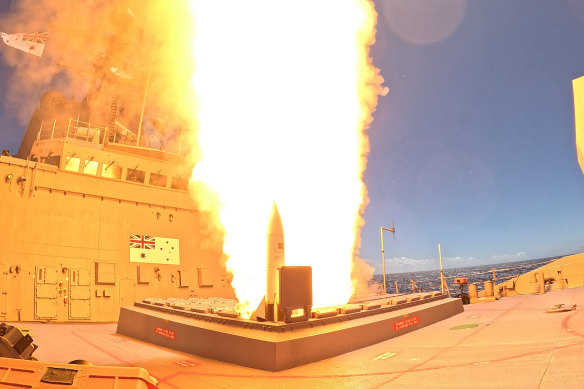Australia will spend $7 billion on a stockpile of long-range missiles from the United States to strengthen its defence capabilities, with Defence Industry Minister Patrick Conroy warning that the world faced the biggest arms race since World War II.
The deal, announced by Conroy overnight in Washington DC and approved by Congress, allows Australia to acquire a suite of hundreds of SM-2 IIIC and SM-6 US-made long-range weapons for the navy that can be fired from land or ship, described by Defence Minister Richard Marles as “the most advanced air and missile defence weapons in the world”.

HMAS Sydney fires Royal Australian Navy’s first Standard Missile 6 (SM-6) near Hawaii during Exercise Pacific Dragon 2024.Credit: ADF LSIS Daniel Goodman
The SM-2 IIIC missiles have a range of 160 kilometres, while the SM-6, with a range of 370 kilometres, was already tested on Australia’s fleet last year. They are capable of targeting and destroying aircraft or incoming missiles in midair. According to manufacturer Raytheon, the weapons have been sold to nations including Canada, Germany, Japan, Korea, Netherlands, Spain and Taiwan.
“Australia faces the most complex geo-strategic environment since the Second World War”, Conroy said in a statement. “Our investment in these world-leading, high-tech missiles is another example of the Albanese government moving fast to keep Australians safe, deter any adversary, and defend Australia’s national interests in the missile age.”
At a press conference in Washington, Conroy refused to say when the missiles would be deployed on Australian warships, saying it could not be disclosed “for operational reasons”. He added that countries in the region had been expecting this announcement and would not be taken by surprise.
Conroy told the Australian Financial Review: “We live in the greatest arms race in our region since 1945 with a high degree of strategic uncertainty” and argued the missiles’ purpose was deterrence.
Marles has said Australia needs to become a “porcupine island” fortified with enough lethal weaponry to prevent an attack from a hostile rival.
Defence spending will soar to $100 billion a year within a decade – double current levels – after the Albanese government directly identified China as the biggest threat in the Indo-Pacific in the new national defence strategy unveiled in April.
While Tuesday’s announcement did not mention China by name, the defence strategy calls out China for employing “coercive tactics in pushing its strategic objectives, including forceful handling of territorial disputes and unsafe intercepts of vessels and aircraft operating in international waters and airspace in accordance with international law”.
“In line with its growing strategic and economic weight, China is improving its capabilities in all areas of warfare at a pace and scale not seen in the world for nearly a century,” the strategy says.
Chinese state media reported on Saturday that President Xi Jinping on Thursday inspected a brigade of the People’s Liberation Army’s Rocket Force, urging the troops to boost their “deterrence and combat capabilities”.
Last month China conducted a rare launch of an intercontinental ballistic missile into the Pacific Ocean, underscoring growing international focus on the country’s nuclear build-up.
Earlier versions of the SM-6 missile have been Australia’s defence forces for more than a decade. Plans to purchase hundreds more of these weapons have been in progress since the Coalition received initial approval from the US State Department in 2021.
Australia is set to start producing long-range strike missiles within three years through a partnership between the federal government and Norwegian defence company Kongsberg. These modern missiles, including naval strike missiles and joint strike missiles, will have a range of more than 275 kilometres and will be manufactured near Newcastle in the NSW Hunter Valley.
Opposition foreign affairs spokesman Simon Birmingham welcomed the missile purchase but stressed the Coalition had been calling for “faster, greater, stronger action”.
“It’s not the announcement that matters,” he told Sky News. “It’s how quickly they can be delivered and installed and give us that capability that matters.”
Greens defence spokesman David Shoebridge took to X to deplore the massive weapons spend: “Australia buys $7 billion of US missiles - another huge defence spend without a clear business case - without a timetable - without sovereign control - and without understanding what else we could do with this like - feed, house and care for people.”
Jennifer Parker, an Adjunct Fellow in Naval Studies at UNSW Canberra and an Expert Associate at the National Security College, Australian National University, hailed the contact as “a positive step forward”.
“It has been known for sometime that Australia had ordered SM6 – with HMAS Sydney firing an SM6 in August this year. This is a positive step forward in the range Australian ships can hit aircraft – but it also provides versatility in its anti-surface capability.”
Cut through the noise of federal politics with news, views and expert analysis. Subscribers can sign up to our weekly Inside Politics newsletter.